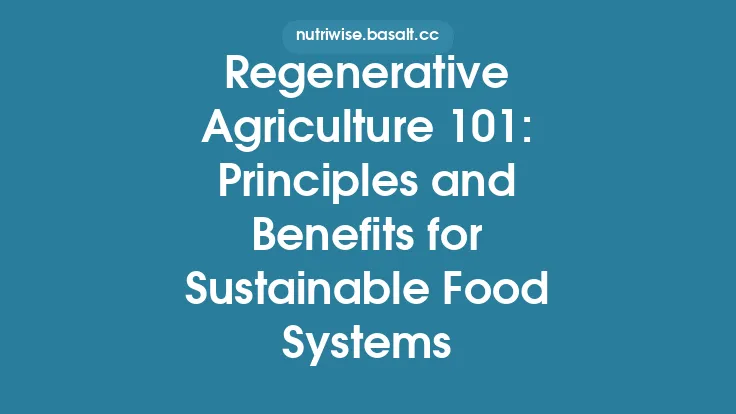Pasture‑raised livestock have become a focal point for consumers who are increasingly concerned about the origins of their food, the wellbeing of the animals that provide it, and the broader implications for human health. While the term “pasture‑raised” is often used as a marketing buzzword, it actually denotes a distinct production system that contrasts sharply with conventional, confinement‑based operations. Understanding the nuances of these two approaches is essential for anyone seeking to make informed choices about the meat, poultry, and eggs they place on their tables.
Defining Pasture‑Raised and Conventional Systems
Pasture‑raised refers to a production model in which animals spend the majority of their lives on open land, grazing on grass, legumes, and forbs, and supplementing their diet with natural forage. The environment is typically managed to provide adequate shelter, water, and protection from predators, but the core principle is that the animals have continuous access to the outdoors and can express innate behaviors such as rooting, pecking, and ranging.
Conventional livestock systems, by contrast, rely heavily on indoor housing—such as battery cages for hens, gestation crates for sows, or feedlots for cattle. Animals are confined to relatively small spaces, receive a formulated grain‑based diet, and have limited or no access to pasture. Environmental enrichment, if present, is often minimal and primarily intended to meet regulatory standards rather than to promote natural behavior.
The distinction is not merely spatial; it encompasses feed composition, animal movement, exposure to sunlight, and the overall management philosophy that guides daily husbandry practices.
Animal Health and Welfare Outcomes
Physical Health
- Musculoskeletal Development: Pasture‑raised animals engage in regular locomotion, which promotes stronger bone density and joint health. Studies on free‑range chickens have shown reduced incidence of leg deformities compared to their confined counterparts. In cattle, grazing encourages natural hoof wear, decreasing the prevalence of foot lesions that are common in feedlot environments.
- Respiratory Health: Outdoor air circulation reduces the buildup of ammonia and other respiratory irritants that are typical in densely populated indoor facilities. This translates to lower rates of chronic respiratory disease in both poultry and swine raised on pasture.
- Parasitic Load: While grazing animals are exposed to external parasites, well‑managed pasture systems employ rotational grazing and strategic deworming protocols that keep parasite burdens at sustainable levels. In contrast, confinement systems often experience higher rates of bacterial infections due to crowding, necessitating more frequent medical interventions.
Behavioral Welfare
- Expression of Natural Behaviors: Access to pasture allows birds to dust‑bathe, forage, and perch, while cattle can graze, ruminate, and engage in social hierarchies. The ability to perform these species‑specific activities is a key indicator of positive welfare, reducing stress‑related behaviors such as feather pecking in chickens or tail‑biting in pigs.
- Social Interaction: Pasture environments typically support larger, more stable groups, facilitating natural social structures. This reduces aggression and the need for artificial segregation that is common in confinement settings.
Nutritional Profile of Pasture‑Raised Products
The diet of an animal directly influences the composition of its meat, eggs, or milk. Pasture‑raised livestock consume a diet rich in diverse plant material, which imparts several measurable differences in the final product:
- Higher Omega‑3 Fatty Acids: Grass‑fed beef and pasture‑raised eggs consistently contain greater concentrations of long‑chain omega‑3 fatty acids (EPA and DHA) compared to grain‑fed equivalents. These fatty acids are associated with cardiovascular benefits for consumers.
- Improved Vitamin Content: Vitamin A (as β‑carotene) and vitamin E levels are elevated in pasture‑derived meat and eggs, reflecting the higher carotenoid and tocopherol content of fresh forage.
- Enhanced Antioxidant Capacity: The presence of natural antioxidants such as flavonoids and phenolic compounds in pasture‑fed animal products can contribute to reduced oxidative stress in the human body.
- Reduced Saturated Fat: While total fat content may be comparable, the proportion of saturated fatty acids tends to be lower in pasture‑raised meat, offering a more favorable lipid profile.
These nutritional advantages are not merely anecdotal; meta‑analyses of peer‑reviewed studies have quantified the differences, providing a robust evidence base for health‑focused consumers.
Consumer Safety and Public Health Implications
Microbial Contamination
Confinement systems, due to high animal density, create environments conducive to the rapid spread of pathogens such as *Salmonella and Campylobacter*. Pasture‑raised operations, with lower stocking densities and greater exposure to sunlight (which has a natural bactericidal effect), often report reduced prevalence of these organisms on carcasses and eggs.
Antibiotic Use
While the article does not delve into the broader topic of antibiotic stewardship, it is noteworthy that the reduced disease pressure in pasture systems typically translates to a lower reliance on therapeutic antibiotics. This indirectly benefits consumers by decreasing the risk of antibiotic‑resistant bacteria entering the food chain.
Allergenicity
Some research suggests that the protein composition of pasture‑raised eggs may be less allergenic for certain individuals, though findings are still emerging. The altered lipid and micronutrient profile could also influence the immunogenic properties of the food.
Economic and Market Considerations
Production Costs
Pasture‑based systems often have lower feed costs because animals derive a substantial portion of their nutrition from grazing. However, land acquisition, fencing, and water infrastructure can increase capital expenditures. Labor requirements may also be higher due to the need for rotational grazing management and pasture maintenance.
Price Premiums
Consumers are generally willing to pay a premium for pasture‑raised products, reflecting perceived health benefits, animal welfare considerations, and environmental values. Market analyses indicate that price differentials can range from 20% to 100% above conventional equivalents, depending on the product category and regional demand.
Supply Chain Dynamics
Pasture‑raised producers frequently operate within shorter, more localized supply chains, reducing transportation costs and carbon footprints. This proximity can also enhance traceability, allowing consumers to connect directly with the farms that raised their food.
Regulatory Landscape and Industry Standards
Although the article avoids certification specifics, it is important to recognize that various governmental and industry bodies have established baseline definitions for “pasture‑raised” or “free‑range” labeling. These definitions typically stipulate minimum outdoor access time, space allowances per animal, and the proportion of diet derived from forage. Compliance with these standards ensures a degree of consistency across producers, even in the absence of formal certification programs.
Challenges and Misconceptions
Land Availability
A common criticism of pasture‑raised systems is the perceived need for large tracts of land, which could limit scalability. In reality, innovative grazing strategies—such as multi‑species grazing and the integration of cover crops—can increase land use efficiency, allowing higher animal densities without compromising welfare.
Seasonal Variability
Feed availability fluctuates with seasons, potentially leading to nutritional gaps during winter months. Producers mitigate this by storing conserved forages (e.g., hay, silage) and supplementing with mineral blocks, ensuring consistent animal health year‑round.
Environmental Impact
While pasture systems can enhance soil carbon sequestration and biodiversity, mismanaged grazing can lead to overgrazing, soil erosion, and water runoff. Effective pasture management, therefore, is essential to realize the environmental benefits and avoid negative outcomes.
Future Directions and Innovations
- Precision Pasture Management: The adoption of GPS‑enabled collars, drone‑based vegetation monitoring, and data analytics allows producers to optimize grazing patterns, improve forage utilization, and reduce labor inputs.
- Hybrid Systems: Some operations are experimenting with “rotational confinement,” where animals spend part of the year in indoor housing during extreme weather, then transition to pasture during milder periods. This approach balances animal welfare with practical constraints.
- Genetic Selection for Forage Efficiency: Breeding programs are focusing on traits that enhance an animal’s ability to digest high‑fiber diets, improving growth rates and feed conversion on pasture without compromising health.
- Consumer Education Platforms: Digital tools that provide real‑time information about farm practices, animal welfare metrics, and nutritional data are emerging, empowering shoppers to make evidence‑based choices.
- Policy Incentives: Governments in several regions are introducing subsidies and tax credits for producers who adopt pasture‑based systems, recognizing their potential contributions to public health and environmental stewardship.
In sum, the divergence between pasture‑raised and conventional livestock production extends far beyond the simple presence or absence of a fence. It influences animal health, behavioral welfare, the nutritional quality of the food we consume, and the broader economic and ecological landscape. While challenges remain—particularly regarding land use efficiency and seasonal feed management—advances in technology, breeding, and policy are steadily narrowing the gap, making pasture‑raised livestock an increasingly viable and attractive option for ethically minded consumers and producers alike.





